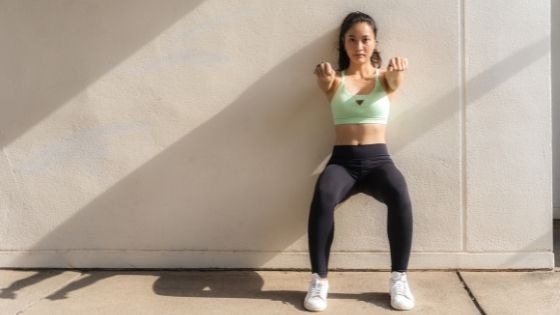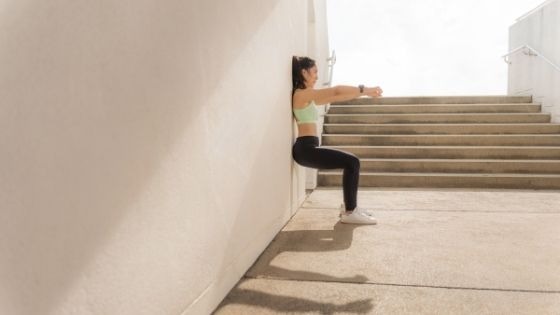Wall Sit, Muscles Worked, and How to Do it Like a Pro!

Do you want to have a toned butt, legs, and core? Wall sits the perfect way to tone your muscles! They’re simple and effective. You can do them anywhere – at home or in the office. Plus, they only take 10 minutes out of your day! We promise that once you start doing wall sits, you won’t be able to stop!
What are Wall Sits?
Wall sits are a form of exercise that you can do to tone your muscles. It's a simple and effective way to work your butt, legs, and core! You don't need any equipment or anything else. You need to be able to stand up against a wall for 10 minutes. Just make sure you can touch the ground if you're using this at the office, or you'll get into trouble.
Wall sits, muscles worked in this exercise.
With the wall sit exercise, you will work especially the quadriceps and other muscles of your legs, glutes, and thorax. It can improve not only muscle tone in those areas but body alignment as well!
By doing wall sit exercises, you will increase your muscle strength in several muscle groups. Also, you'll find you're better able to do more difficult exercises.
Wall Sit Benefits
There's a great list of benefits you'll receive by doing wall sits effectively. For example, Wall sits can strengthen the muscles you don't normally see when you look in the mirror.
Every muscle you have works to keep you in an upright position, allowing you to move your legs without toppling over onto the floor. A wall sit will strengthen these muscles you otherwise wouldn't use too much.
Wall sit benefits you can expect:
They burn a lot of calories.
The squats wall sits are a kind of workout where you stay still on the ground for a few seconds. It might make your heart start to beat faster, and then you burn more calories in that area and your whole body.
They increase your muscle strength and overall fitness
Wall sits build muscle, it is true. A wall sit workout can help to improve your muscular endurance and body alignment. You will strengthen your abdominal muscles, along with the back of your legs, as you push your buttocks out behind you throughout the exercise.
You will avoid injuries.
Wall sits are a good way to work your lower body. They are safer than squats and deadlifts because you only need your body weight to get the most exercise.
Squats and deadlifts can make your back hurt, but not wall sits. Wall sits can be done by people of all ages, from children to seniors.
It is a fun exercise to do
There have been hundreds of online wall sitting competitions and challenge activities. Some require the whole family, ranging from 7 to 70, while others are restricted to relatives.
They also help you improve your balance.
The more you do wall sits, the stronger you become. The better your physical condition is the larger your chance of avoiding injuries. In addition to strengthening your muscles, you'll also have better control over your body, and you will gain a better sense of balance.
They are a great alternative to squats.
Wall sits are an alternative to squats you should try. This is because you don't need much room or equipment and you can do them almost anywhere.
You need enough room to stand up against a wall, and you're good to go! That is why you should take advantage of this opportunity as you can do them during your 10-minute break.
How to do a Wall Sit

The wall sit is one of the few exercises you can do that you don't need any equipment to perform. Therefore, you can do it just about anywhere you have a flat surface to rest your back against in a standing position.
Here's how you begin:
- To get the wall sit position, place your feet shoulder-width apart and ensure you're directly in front of a flat wall.
- Lean your back against the wall, and slide your back down the wall until you have a 90-degree angle in your knees.
- Make sure you keep your heels on the floor and hold that position without moving for as long as you can.
- You will feel your quadriceps and glutes burning during this time. If you need to adjust yourself, you can take a break.
- When you feel strong enough, hold the wall sit for longer periods of time to get better results.
That's it! Get ready to increase your metabolism and work some muscle you never knew you had.
Tips for doing wall sits
Be in front of a wall. Then, you can slide your back down. Use a timer if you need to. For example, try counting to 30 the first time you try it or set a phone alarm for 10 minutes.
Improve your posture by pulling your shoulders back and puffing up your chest as you do this exercise. Make sure you have good form when you do the wall sits.
You don't want your feet to move, or you'll be cheating yourself out of the full results you could achieve. This may require you to turn your toes inward slightly so that you're pushing off from the outsides of your feet.
Remember to always consult your doctor before doing this exercise if you have any existing medical conditions or injuries you might have.
Variations of the Wall Sit
Stability ball wall sit
You can hold a stability ball, and you may also want to lift your arms forward and raise the arm to maintain your stability in squats regularly. This one is a great workout for your upper body, feet, and glutes. It is perfect for beginners.
People think this variation of standard wall sit is easier psychologically because they're focused on the ball but not about how tired or sore their legs might be.
Repetitions: 5-10 for beginners/10-15 for others. You can enjoy a greater range of motion without the risk of injury without injury risk.
People find it easier psychologically to focus less on how tired their legs are. So it would be easier to concentrate on the ball instead.
Weighted wall sit
You can hold a barbell or dumbbell in your lap to make this workout even more difficult for you. Variations you might see people using include holding the weights at their sides or behind them, with hands on the floor and/or overhead. This one is good for your legs, glutes, abs, and cardio.
Single-leg wall sit
This wall sit variation is a lot harder as you only need to use one leg. Be sure you have something you can hold on to for balance and protection. You'll be surprised at how much core strength you need if you want this movement to succeed. This single-leg wall sit is also ideal for people who are just starting to practice wall sits.
Repetitions: you can hold the position for up to 15 seconds before you need a break. Gradually increase the amount of time you hold your leg in this position.
This makes it easier to concentrate on one leg while you do it. You could also combine this with some core strength and balance training exercises.
Add upper body exercises.
When you sit down, your muscles get stronger. So if you add more upper body movements to what you are doing, it will make your muscles work harder and get stronger.
You can grab dumbbells, and you can perform bicep curls or side raises. This is another great way to strengthen your upper body.
How often should I do a wall sit during my workout routine?
You can do a wall sit when you are truly bored or feel you have nothing else to do in your workout routine. Ideally, it would be best to do this exercise at least two times per week, and you need to aim for 10 reps each time you do it.
Wall sits might not look like they're completely challenging on the surface, but you'll be surprised how hard you begin to breathe during this exercise as you get more tired.
If you want to make your wall sits even more challenging, you can place a resistance band around your legs. You can also use the resistance band when you're just starting and need some assistance keeping your legs up.
Do wall sits work your abs?
While you might think you're just focusing on your legs, you're actually putting in work for your entire body. The body area that needs the most work when you do this is your abs, which stabilize you as you push out to hold the position.
With every exhale, focus on pulling up on your abdominals and lifting your kneecaps and tailbone off from the floor. You'll get maximum results if you join a few wall sits with other exercises that use those areas of the body, like planks or squats with shoulder presses.
If you want to make it even more challenging, try adding resistance bands around your legs or replace one of each leg's muscles with a dumbbell between them but be careful because this wall sit is pretty tough.
This whole list of wall sits you've just read about will definitely make you stronger and improve your workout performance. Still, also you'll see the results faster if you combine the above-mentioned with other exercises like squats, lunges, or leg extensions.
Conclusion
So, what is the conclusion of this blog post? The answer is that wall sits work all your major muscle groups. There are many benefits to doing these exercises, and it’s important not to overdo them to maintain good form and avoid injury.
It is important to note that the wall sit exercises are excellent for you and your muscles. In addition, Wall sits will help reduce a person’s weight and risk of diabetes, heart disease, or high blood pressure. (Trusted sources 1*, 2*, 3*)
Medically reviewed and approved by Nataniel Josue M D.
